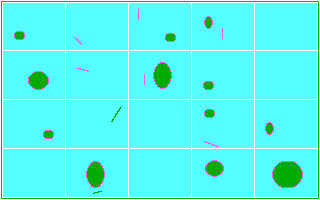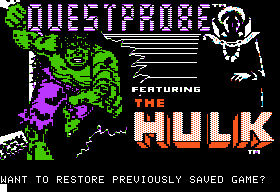Read the manual and accompanying comic here:
Scott Adams' Adventureland was one of the first whales I covered, and the first adventure to make whale status. An aggressively truncated adaptation of Don Wood's Adventure, it entertained me more than its colossal ancestor did, thanks to its near-absence of empty space and somewhat cleverer puzzles. Nevertheless, it was made comically obsolete by Zork I in 1980 just a little over a year later. Adams would churn out a dozen text adventures between 1978 and 1981, all
within the 16KB constraints of Adventureland's two-word BASIC engine, few of which are given much veneration in modern retrospectives.
Fast-forward to the current year of 1984, and there have been massive developments in the genre. Infocom, of course, is a class of its own in terms of writing, parser sophistication, world building, storytelling, puzzles, and interactivity, with ten so-called "interactive fiction" titles and counting produced by a stable of authors, half of which made my ivory deck. Ken & Roberta Williams pioneered graphical adventures three times, with crude wireframes in Mystery House, full color in The Wizard and the Princess, and the fully animated pseudo-3D King's Quest. In the UK, where tapes were still the most widespread computer games media, Level 9 crammed massive worlds into 32KB memory spaces with compression algorithms and other cleverness, and The Hobbit offered a dynamic world driven by physics and independent actors, albeit one where nothing that happens and nothing that anyone does makes any kind of sense.
Adams had still been active, and his back catalog, easily portable thanks to having a common codebase sold rather well abroad on low-end computers, but none of his output past 1979's The Count (which I played but did not cover) flew on my radar. By 1982, he started re-releasing his adventure series with graphics on the Apple II and other platforms as the SAGA (Scott Adams Graphical Adventure) series. Without any expanded content or prose, they are still the same old primitive and terse text adventures, only accompanied with illustrations that sometimes hinder gameplay. In 1984, he followed-up the original twelve adventures with two all-new SAGA engine games, but they flopped. Graphics just weren't a novelty any more, and Adams' mold was years obsolete.
This brings us to the Questprobe series, a collaboration with Marvel Comics that produced two whales, his first since Mission Impossible. This series would be the final games of Adventure International, and to be frank, I'm not looking forward to them. The picture being painted here is a desperate Hail Mary to save a moribund studio whose design sensibilities never evolved from its primordial origins - an evidently unsuccessful one - and the way the manual condescendingly tells us "your computer can't understand" commands with more than two words doesn't enhearten.

Included with each game is a comic book detailing the backstory. Here, a coalition of prosperous, pacifistic worlds learns the consequences of beating swords to plowshares as a mysterious fleet of space invaders destroys planet after defenseless planet. In the high council, whose robed members look like Kanamites from The Twilight Zone, one "Durgan the Philospher" observes that though generations of peace have left his people unwilling to fight for their lives, other worlds have heroic defenders.
Meanwhile, Hulk is fighting the national guard yet again, and singlehandedly smashes a platoon of tanks into scrap metal, carving a second Grand Canyon into Colorado in the fracas, much to the amazement of a space-helmeted observer. Introducing himself as the Chief Examiner, Hulk retorts that he has no wish to be examined, and they fight for a several more pages, where he is tricked into jumping through a magic portal, and comes out the other side weakened. The events of the game, we're told, show what happened in the split-second of existing in the portal dimension.
Although the Apple II version wasn't released until 1985, Adams informed me in an email that this was indeed the lead development platform for the Questprobes, as it was for all SAGA engine games. This version also apparently has voice output, but neither the game nor the manual identifies the supporting hardware, and I couldn't get it to work at all. Oh well.
So we begin as Bruce Banner, alone and tied to a chair in some kind of bunker. I let "D" have a first shot at it.
>GET MAD
HOW?
>BE HULK
DON'T KNOW HOW TO "BE"
>OK, HAMLET
DON'T KNOW HOW TO "OK"
You and me both, Hulk.
Conceding the keyboard to me, I found "ROCK CHAIR" had the desired effect.
 |
The graphics transition as screen-wipes and are rendered remarkably fast compared to similar games on the old Apple.
|
You wouldn't know it from the final image, but as soon as you start typing, the graphic is replaced by a much more useful text description of the room, listing the visible items here; a mirror, a broken chair, a gem, and a metal hand fan, as well as the immovable hatch in the floor and the sign, which explains the quest:
THIS COMPUTER MODEL HAS BEEN CREATED SO
THAT YOU WILL LEARN TO PERFORM AS THE
HULK! TO PROVE YOU CAN SUPPLY THE
BRAINS AS WELL AS CONTROL THE HULK'S
BRAWN YOU MUST COLLECT ALL THE *GEMS AND
STORE THEM INTO THE PROPER LOCATION.
GOOD LUCK!
Whee, another treasure hunt adventure!
Connected to this room is a tunnel in which a sign warns us of "hi grav" ahead, and a button here, when pushed, activates a voice that announces "DELAY ON." Leaving is instantly fatal, but since this is a computer simulation, the only consequence is a gentle chastisement from the Chief Examiner and a free respawn in the bunker.
I had to look up what to do next. BITE LIP summons Hulk anytime, though the nerve gas will revert you back quickly. PUNCH MYSELF works too and seems a bit more thematically appropriate. Either way, the button effect delays the gas just long enough to leave.
Freedom and gem awaited outside, where I began Trizborting. And very soon stopped Trizborting.
Every direction you go leads to a "fuzzy area" of impossible objects where a signpost indicates a drop-off point for the gems. Going north leads to a dead-end where an egg explodes, killing you and destroying a "bio gem," and if you return after resurrection, there's no way out and eventually nerve gas floods the room and kills you again. Going any other direction leads to one of three random fields, each with a dome to enter, or rarely the Chief Examiner's office, where a gem can be stolen from his desk. The random fields contain one gem each, one is infested with giant ants and its dome contains two more gems, and the third dome has a box of wax that you can't get because bees will sting you.
Seven gems collected were worth 41/100 points, suggesting a total of 17. But I was stuck. The walkthrough told me that you can lift the domes from the outside, which I did, revealing yet more gems, and also that I could dig holes, where I found more. The dome with the ants was pretty annoying as I had to leave after every single action so that the ants didn't kill me, and then stumble around the fuzzy room until it randomly brings you back.
That's 13 gems, worth 76 points.
Stuck again, the walkthrough told me to EXAMINE DOME (the one with the wax and bees) to spot a grate on the back, which you can wave the fan at to drive the bees away, and then get the wax.
Next - I once again needed the walkthrough - you must go to the dome where the ants lurk and BITE LIP inside. This summons Dr. Strange, who reveals the gas vent's location, which you can then plug up with the wax.
TALK STRANGE three times and he drops some cryptic advice ("REMEMBER YOUR WORST ENEMY NIGHTMARE"), and another gem.
REMEMBER NIGHTMARE triggers a graphic that vanishes faster than you have a chance to see it - and lets him resist the nerve gas in the domes just long enough to rip open the hatch in the starting room, leading to the cul-de-sac with the exploding egg.
_000000000.png)
Drop through the hole, though, and you've softlocked the game, because there is now nothing you can do to stop the egg from exploding and killing you, and more importantly, destroying the gem. You've got to open the hatch so that there's a way out of the room, but then go back to the "fuzzy area," REMEMBER NIGHTMARE there, and then go north to enter from the other side, where you can EAT EGG to save the gem.
From here, the walls can be scratched to reveal a passage into a cavern. But you've got to REMEMBER NIGHTMARE as your every alternating move in order to resist the nerve gas that permeates the indoor areas.
Ultron here has Ant-Man trapped in a cage. Also there's a gem to take, which is just about the only thing I could do without Ultron's interference. The gas flows here, too, so once again every other move must be REMEMBER NIGHTMARE or else you go back to Bruce. Speak to Ant-Man and he asks you to bring his friends.
What you have to do is get the giant ants, who will normally attack your eyes, but if you type CLOSE EYES they'll attack your nose instead. Hold your nose first and then close your eyes, and they'll attack your ears. Plug your ears with wax, then hold your nose, and then close your eyes, and you can get the ants safely. Then you've got to blindly find your way back to Ant-Man, where they'll destroy Ultron. Ant-Man then gives you the last gem.
I dropped it off, and then, nothing happened. The command SCORE said I collected 16 gems for 94 points, but this was the 17th gem! So I turned to the walkthrough one more time - the "Bio gem" apparently has to be the last one dropped off or else the final gem doesn't count. So I replayed the entire game, got very annoyed with the time wasted constantly wandering the "fuzzy area" whenever I needed it to randomly take me to a specific dome, and completed it properly.
_000000000.png)
GAB rating: Bad. While not the worst adventure I've ever played, Hulk is astoundingly bad. The concept was crummy from the start - why does a Hulk adventure mainly involve finding gems and dropping them off at a location, and so little smashing? Scott Adams himself had moved on from that format, albeit in baby steps, in 1979! The graphics aren't bad considering the system limitations and they're drawn much more quickly than Sierra's Hi-Res Adventures, and I guess the ant puzzle is a bit clever, but other than that this is an obtuse and barebones treasure hunt with trivial yet sometimes unreasonable puzzles and multiple annoying gameplay mechanics.
One more of these and I will close the book on Adventure International forever.
My Trizbort map:



























_000000000.png)

_000000005.png)
_000000000.png)
_000000002.png)
_000000000.png)
_000000000.png)
_000000000.png)
_000000000.png)










